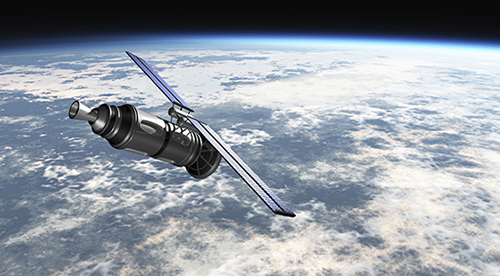
MANAGING ACCESS TO PETABYTES OF DATA
Quantum Data Management Software Manages Earth Observing Data Archive
Every day, NASA's Earth Observing System satellites beam down terabytes of data about the earth, oceans, and atmosphere. The data is made available to climate researchers around the world using NASA's Earth Observing System Data and Information System (EOSDIS)—one of the most ambitious data projects ever conceived. The storage of this irreplaceable information is entrusted to Quantum's data management software.
Escalating Data Growth Since going online in 1999, NASA's EOSDIS has become one of the world's largest and most active data repositories. Every day, it receives 3 terabytes of new data and distributes 2 terabytes of existing information to researchers around the world, giving hundreds of thousands of users access to more than 20 million files containing over a petabyte of information.
The core EOSDIS components were developed by Raytheon Imagery and Geospatial Systems. “This data is a national resource that will provide tremendous insight into how the earth is changing,” says Raytheon's Project Technical Director. "Storing it, organizing it, and making it available to researchers are critical tasks and a huge challenge."
The scale of the task meant that the system needed to be structured so that applications could write data and read it directly from automated tape libraries. "…we needed a robust storage system that could scale to handle massive data sets stored on multiple types of media,” Raytheon's Project Technical Director explains. “We also needed a stable solution that could support 24/7 operation.”
High-Performance Data Access with Disk and Tape Key to EOSDIS success was developing a system for managing high-speed disk cache that keeps metadata persistently available for rapid searches of millions of files and petabytes of primary data that are stored on tape. Quantum's data management software ties the whole system together and lets users access it effectively.
Quantum’s data management software transforms tape libraries into online, direct-access mass storage—enabling users, administrators, and applications to archive petabytes of data. Quantum’s data management software presents automated tape libraries as one device and one UNIX mount point, so that users can access files residing on tape libraries in the same way they would with disk devices. Quantum’s data management software manages disk cache, maintains metadata online in highly available server clusters, and scales to manage an effectively unlimited number of files.
“The completed system lets us get the most efficient use possible out of our storage resources,” Raytheon's Project Technical Director continued. “It gives us a high-performance, very resilient storage environment, easy access to the data from all our applications, and it gives us massive resource leverage. All of the file retrieval, staging to disk cache, and delivery as a file or duplicate set of media happens in the background.” To the users who access the data through the EOSDIS Web site, data appears as though it were stored in a single database.
Support from Quantum that helped with system architecture and provided ongoing service was critical to the project's success.Raytheon's Project Technical Directorconcludes, "Overall commitment to this project from the primary vendors has been one of the keys to its success.”
Cloud computing company VMware Inc., a subsidiary of EMC, will stay an independent, publicly traded company.
Dell Inc.'s headquarters will stay in Round Rock, Texas. The combined enterprise systems business headquarters will be in Hopkinton, Massachusetts, where EMC is based.
The deal, which was approved by EMC's board, is targeted to close in the second or third quarter of Dell's fiscal year ending Feb. 3, 2017. It still needs approval from EMC shareholders.
Dell, started by Michael Dell in 1984 when he was just a teenager, went on to change the PC business with low costs, customized orders and direct sales first over the phone and later the Internet.
EMC's stock rose 83 cents, or 3 percent, to $28.69 in premarket trading about 15 minutes before the market open on Monday.

"We needed a robust storage system that could scale to handle massive data sets stored on multiple types of media. We also needed a stable solution that could support 24/7 operation."
~Raytheon EOSDIS Project Technical Director
PRODUCTS USED
- Application: Automated storing and accessing of NASA satellite data
- Quantum’s Data Management Software
- Tape Storage: Automated tape libraries
- Server and Storage Environment: SGI IRIX servers
KEY BENEFITS
- Provides highly reliable archive with massive scalability
- Supports multiple media types—tape for primary storage and disk cache for high-speed search
- Allows global community of users to access data directly
- Active support from Quantum provides key to successful implementation
- Integrates with wide range of UNIX platforms